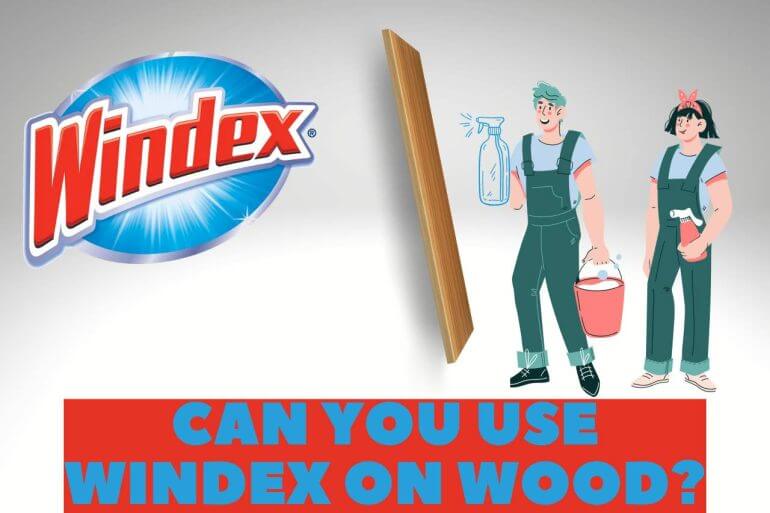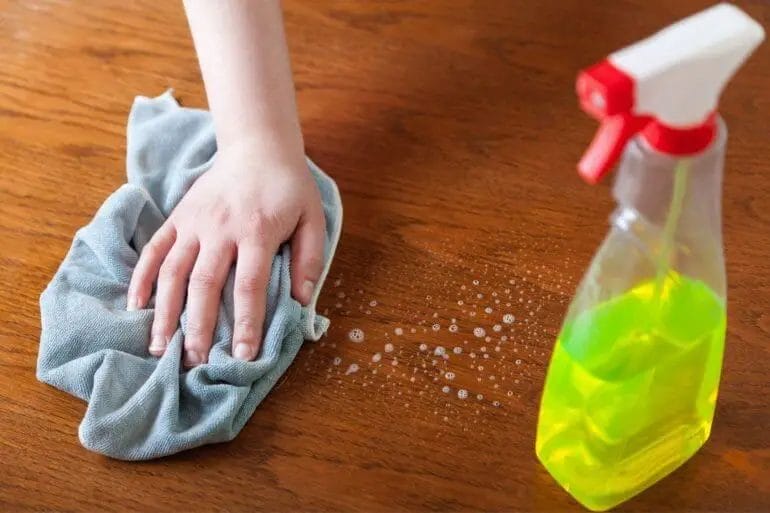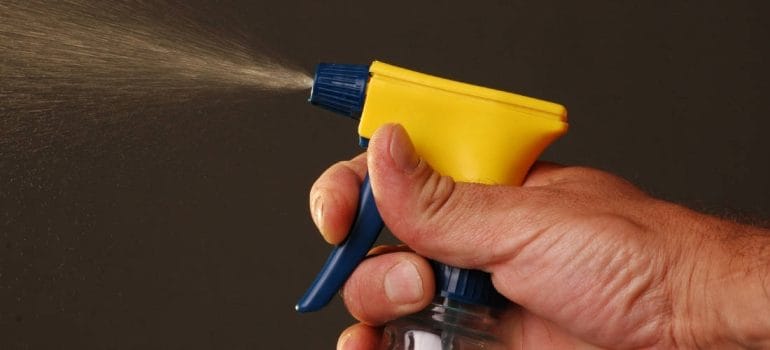Using Windex on wood is not recommended as it is primarily designed for cleaning glass surfaces.
The chemicals in Windex can potentially damage the finish of the wood, causing it to become dull or even discolored.

It is best to use products specifically formulated for cleaning and treating wood surfaces to ensure their longevity and appearance.
These products are gentle and designed to effectively remove dirt and grime without harming the wood’s finish.

Alternatives to Using Windex on Wood
When it comes to cleaning wood surfaces, many people reach for Windex as a convenient solution. However, using Windex on wood can actually cause damage over time. The harsh chemicals in Windex can strip away the protective finish on wood and leave it looking dull and worn. Fortunately, there are several alternatives to using Windex that are safe and effective for cleaning wood. In this section, we will explore some of the best alternatives for cleaning wood surfaces.
1. Vinegar and Water Solution
One of the most popular alternatives to using Windex on wood is a simple solution of vinegar and water. Vinegar is a natural cleaning agent that is safe for use on most wood surfaces. To create a vinegar and water solution, simply mix equal parts of white vinegar and water in a spray bottle. Spray the solution onto the wood surface and wipe clean with a soft cloth. Vinegar not only cleans the wood but also helps to remove grease and grime.
2. Lemon Juice and Olive Oil Mix
If you’re looking for a natural alternative to Windex that also adds shine to your wood surfaces, try a mixture of lemon juice and olive oil. Lemon juice acts as a gentle cleaner and disinfectant, while olive oil helps to moisturize and protect the wood. Mix one part lemon juice with two parts olive oil in a small bowl. Apply the mixture onto a soft cloth and rub it onto the wood in circular motions. Let it sit for a few minutes and then buff the surface with a clean cloth to remove any excess oil.
3. Furniture Polish
If you prefer a ready-made solution, there are many furniture polishes available on the market that are specifically designed for cleaning and conditioning wood. Look for polishes that are free of harsh chemicals and contain natural ingredients like beeswax or coconut oil. Apply the polish directly onto the wood surface and use a soft cloth to buff it in. This will help to restore the shine and protect the wood from future damage.
4. Mild Soap and Water
For light cleaning of wood surfaces, a mild soap and water solution can be used as an alternative to Windex. Mix a few drops of mild dish soap with warm water in a bucket or basin. Dip a soft cloth or sponge into the soapy water and wring out any excess moisture. Gently wipe down the wood surface, being careful not to saturate it. Rinse the cloth or sponge with clean water and wipe away any soap residue. Dry the wood thoroughly with a clean towel.
5. Commercial Wood Cleaner
If you prefer the convenience of a commercial cleaner, there are many wood-specific cleaning products available that are formulated to effectively clean and protect wood surfaces. Look for products that are specifically designed for the type of wood you are cleaning, such as hardwood or laminate. Follow the instructions on the packaging for best results and always test the cleaner on a small, inconspicuous area before applying it to the entire surface.
In summary, while Windex may seem like a convenient option for cleaning wood, it can actually damage the surface over time. Instead of using Windex, consider trying alternatives such as a vinegar and water solution, a mixture of lemon juice and olive oil, furniture polish, a mild soap and water solution, or a commercial wood cleaner. These alternatives will effectively clean your wood surfaces without causing any harm. Remember to always test any new cleaning product or method on a small area first to ensure compatibility with your specific wood type.

How to Safely Clean Wood Surfaces without Windex
Wood surfaces require special care and attention when it comes to cleaning. While many people turn to Windex for their cleaning needs, it’s important to note that this popular household cleaner may not be suitable for use on wood. Windex contains chemicals that can potentially damage the finish and integrity of wood surfaces. Fortunately, there are several alternative methods for safely cleaning wood surfaces without Windex.
1. Vinegar and Water Solution
Vinegar is a natural and effective cleaner that can be used on a variety of surfaces, including wood. To create a vinegar and water solution, mix equal parts of white vinegar and water in a spray bottle. Spray the solution onto a microfiber cloth and gently wipe the wood surface in the direction of the grain. Avoid saturating the wood with the solution, as excessive moisture can cause damage. Vinegar helps remove dirt and grime while leaving the wood surfaces clean and shiny.
2. Lemon Juice and Olive Oil Mixture
If you’re looking for a more natural and fragrant option, a lemon juice and olive oil mixture can be used to clean wood surfaces. Mix equal parts of fresh lemon juice and olive oil in a bowl. Dip a soft cloth into the mixture and gently rub it onto the wood surface. The lemon juice acts as a natural cleaner, while the olive oil nourishes and moisturizes the wood, leaving it looking revitalized and polished.
3. Dish Soap and Water Solution
For everyday cleaning of wood surfaces, a simple dish soap and water solution can be highly effective. Fill a bucket or basin with warm water and add a few drops of mild dish soap. Dip a sponge or soft cloth into the solution and wring out any excess liquid. Gently wipe the wood surface, being careful not to scrub too vigorously. Rinse the cloth or sponge frequently to avoid spreading dirt or soap residue. Once clean, use a dry cloth to remove any remaining moisture.
4. Baking Soda Paste
Baking soda is a versatile and non-abrasive cleaner that can be used to remove stubborn stains from wood surfaces. To create a baking soda paste, mix baking soda with a small amount of water until it forms a thick consistency. Apply the paste onto the stain and gently scrub the area with a soft cloth or sponge. Rinse the surface with water and dry it thoroughly. The baking soda paste helps lift stains without causing any damage to the wood.
5. Commercial Wood Cleaner
If you prefer to use a ready-made cleaner specifically formulated for wood surfaces, there are plenty of commercial wood cleaners available in the market. Look for products that are specifically designed for the type of wood you are cleaning, whether it’s hardwood, laminate, or veneer. Follow the instructions on the packaging and use the cleaner as directed. Always test the cleaner on a small, inconspicuous area of the wood surface before applying it to the entire surface to ensure compatibility.
Summary
When it comes to cleaning wood surfaces, it’s important to avoid using Windex or other harsh chemicals that can potentially damage the wood. Instead, opt for safer alternatives such as vinegar and water solution, lemon juice and olive oil mixture, dish soap and water solution, baking soda paste, or commercial wood cleaners. Always follow the appropriate cleaning method for the type of wood you are working with and test any new cleaning solution on a small area before applying it to the entire surface. By using these safe and effective cleaning methods, you can keep your wood surfaces looking clean and beautiful for years to come.

Common Mistakes to Avoid When Cleaning Wood with Windex
Wood furniture and surfaces require special care to maintain their beauty and longevity. One popular cleaning solution that many people turn to is Windex, a household cleaner known for its effectiveness on glass surfaces. While Windex can be used to clean certain types of wood, there are common mistakes that should be avoided to prevent damage. In this section, we will discuss these mistakes and provide helpful tips for safely cleaning wood with Windex.
1. Using Windex on untreated or unfinished wood
One major mistake to avoid is using Windex on untreated or unfinished wood surfaces. Windex contains ammonia, which can be too harsh for these types of wood. Ammonia can strip away the natural oils and moisture from the wood, leading to dryness, discoloration, and even cracking. It is essential to know the type of wood you are cleaning and whether it has a protective finish. If your wood is unfinished or lacks a protective seal, it is best to use a gentle, specifically formulated wood cleaner instead.
2. Spraying Windex directly onto the wood
Another common mistake is spraying Windex directly onto the wood surface. This can result in oversaturation and excessive moisture, which can harm the wood. Instead, it is recommended to spray Windex onto a soft, lint-free cloth or paper towel and then gently wipe the wood. This allows you to control the amount of cleaner applied and prevent it from seeping into the wood grain.
3. Using abrasive materials for wiping
Using abrasive materials, such as rough sponges or scrub brushes, to wipe the wood can cause scratches and damage to the surface. It is important to choose soft, non-abrasive cloths or microfiber towels for cleaning. These materials are gentle on the wood while effectively removing dirt and grime.
4. Neglecting to test in an inconspicuous area
Before cleaning wood with Windex, it is crucial to test the cleaner in an inconspicuous area. This allows you to assess any potential adverse reactions or damage that may occur. Apply a small amount of Windex to a hidden spot and observe the wood’s reaction. If there is no discoloration or damage after a few minutes, you can proceed with cleaning the rest of the wood surface.
5. Allowing Windex to sit on the wood for too long
Leaving Windex on wood for an extended period can lead to moisture penetration and damage. After applying Windex to the wood, promptly wipe it clean with a dry cloth. This prevents excessive moisture from being absorbed, which can cause warping or swelling of the wood.
6. Not following up with proper wood maintenance
Cleaning wood with Windex should be followed by appropriate wood maintenance to keep the surface in optimal condition. After removing any dirt or grime, it is recommended to apply a suitable wood polish or conditioner to restore moisture and protect the wood. This step helps prevent drying and cracking, keeping the wood looking its best for years to come.
In summary, cleaning wood with Windex can be done safely and effectively if certain mistakes are avoided. It is important to consider the type of wood, avoid direct spraying, use gentle materials, test in an inconspicuous area, remove excess moisture promptly, and follow up with proper maintenance. By following these tips, you can ensure that your wood surfaces remain clean and beautiful without any damage.
DIY Natural Cleaning Solutions for Wood Surfaces
Wood surfaces add warmth and beauty to our homes, but they require regular cleaning to maintain their appearance and longevity. While there are many commercial cleaning products available on the market, they often contain harsh chemicals that can be harmful to both our health and the environment. Fortunately, there are several DIY natural cleaning solutions that are effective, affordable, and safe to use on wood surfaces. In this section, we will explore some of these natural cleaning solutions that you can easily make at home.
Vinegar and Water Solution
Vinegar is a versatile household ingredient that can be used for various cleaning purposes, including cleaning wood surfaces. To make a vinegar and water solution, simply mix equal parts of white vinegar and water in a spray bottle. Shake the bottle well to ensure the ingredients are evenly mixed. This solution is suitable for general cleaning and can effectively remove dirt, grease, and grime from wood surfaces.
To use the vinegar and water solution, spray it onto a microfiber cloth or directly onto the wood surface. Gently wipe the surface with the cloth, following the grain of the wood. For stubborn stains or sticky residues, you can let the solution sit on the surface for a few minutes before wiping it off. Remember to dry the surface thoroughly after cleaning to prevent any water damage to the wood.
Olive Oil and Lemon Juice Polish
If you want to restore the natural shine and luster of your wood surfaces, a homemade olive oil and lemon juice polish can do wonders. In a small bowl, mix together 1/4 cup of olive oil and the juice of one lemon. Stir the mixture well to combine the ingredients. This polish not only cleans the wood but also nourishes and moisturizes it, preventing it from drying out.
To use the olive oil and lemon juice polish, apply a small amount onto a soft cloth and gently rub it onto the wood surface in circular motions. Let the polish sit for a few minutes to allow the oil to penetrate the wood. Then, using a clean cloth, buff the surface until it shines. This natural polish is suitable for all types of wood surfaces, including furniture, cabinets, and floors.
Baking Soda and Water Paste
Baking soda is known for its cleaning and deodorizing properties, making it an excellent natural cleaner for wood surfaces. To make a baking soda and water paste, mix equal parts of baking soda and water in a small bowl until a thick paste forms. This paste can effectively remove stains, scuffs, and water rings from wood surfaces without causing any damage.
To use the baking soda and water paste, apply a small amount onto a damp cloth and gently rub it onto the stained area. Let the paste sit for a few minutes to allow it to work its magic. Then, using a clean cloth, wipe away the paste and rinse the area with water. Dry the surface thoroughly to prevent any moisture from seeping into the wood.
Tea Tree Oil and Water Solution
Tea tree oil is a natural antiseptic and antimicrobial agent that can be used to disinfect and clean wood surfaces. To make a tea tree oil and water solution, mix a few drops of tea tree oil with water in a spray bottle. Shake the bottle well to ensure the ingredients are well combined. This solution is particularly useful for cleaning cutting boards, wooden utensils, and other food contact surfaces.
To use the tea tree oil and water solution, spray it onto the wood surface and wipe it clean with a cloth. The antimicrobial properties of tea tree oil will help kill bacteria and prevent the growth of mold and mildew. This solution is safe to use and does not leave any harmful residues on the wood.
Summary
Cleaning wood surfaces with natural solutions not only helps to maintain their beauty but also promotes a healthier living environment. Vinegar and water solution can effectively remove dirt and grime, while olive oil and lemon juice polish restores the natural shine of wood. Baking soda and water paste is great for removing stubborn stains, and tea tree oil and water solution is perfect for disinfecting food contact surfaces. By using these DIY natural cleaning solutions, you can keep your wood surfaces clean and well-maintained without compromising on your health or the environment.
FAQs
Can I use Windex on wood?
No, it is not recommended to use Windex or any ammonia-based cleaner on wood surfaces. These cleaners can strip away the wood’s finish and cause damage. Instead, use a mild soap and water mixture or a wood-specific cleaner to clean and maintain the beauty of your wood surfaces.
Conclusion:
In conclusion, using Windex on wood is not recommended. While Windex is a popular and effective glass cleaner, it contains chemicals that can be harmful to wood surfaces. The harsh chemicals in Windex can strip the natural oils and protective finishes of wood, leading to potential damage, discoloration, and even warping. It is best to avoid using Windex on wood and instead opt for products specifically designed for cleaning and maintaining wood surfaces. Always read and follow the instructions provided by the manufacturer to ensure the longevity and beauty of your wood furniture or flooring.